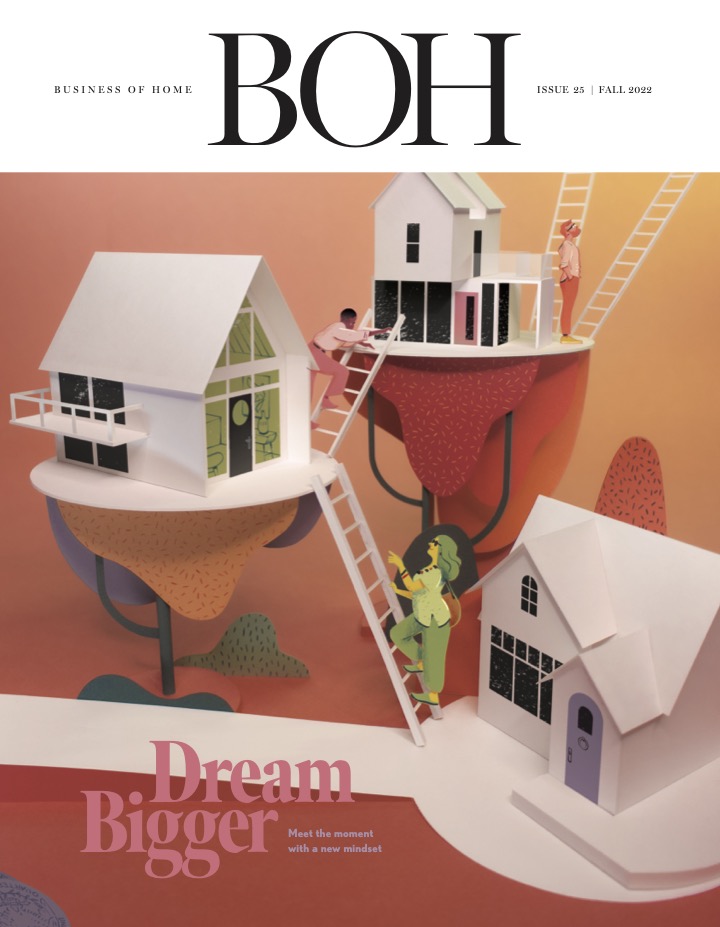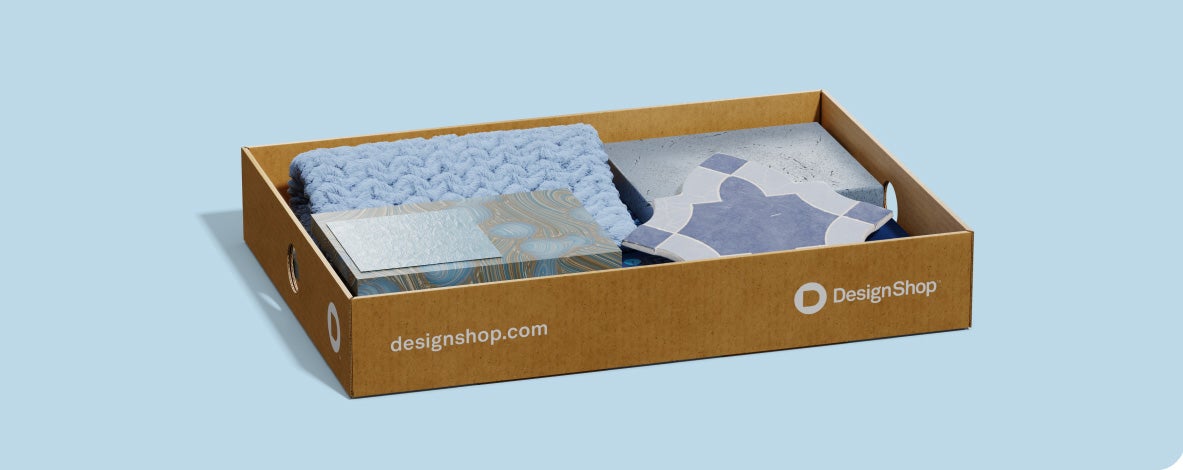Overnight samples aren’t just for designers anymore. Last month, Material Bank quietly debuted its long-rumored consumer-facing platform, DesignShop. The site—with its browsable library of materials and lightning-quick shipping time—closely mirrors Material Bank, except the samples cost money, and no trade credentials are required. Anyone with a credit card and a late-night jonesing for leather swatches can get a boxful the next day.
Developing a platform for consumers, says Material Bank founder Adam Sandow, was part of the plan from the early days. “As soon as I saw how engaged brands [as well as] architects and designers were, I thought, ‘Boy, how amazing would it be if I could take the same technology and logistics and provide consumers with the seamless experience we give to the design industry?’” he tells Business of Home.
DesignShop operates on the same rails as Material Bank—its samples are shipped from the same central logistics hub in Olive Branch, Mississippi, packed (in some cases) by the same squad of canary-yellow robots. Even the value proposition of the two sites, says Sandow, is essentially identical. “I’m fixated on what I like to call the convenience economy,” he tells BOH. “Everyone is part of it—when you press a button on Uber, Doordash or Instacart. The consumer is being trained—and is candidly demanding—the conveniences of speed and variety. In some cases you can walk into a store and they’ll give you samples for free, but some consumers don’t have two hours on a Saturday to go to three tile stores.”
What’s different is the business opportunity. While the design industry has a daily need for samples, the market is only so big as a whole. The pool of consumers looking to tweak their homes (along with the contractors who help them) is far, far bigger. For Material Bank, a company that has raised over $325 million at a $1.9 billion valuation, it’s a target too appealing not to aim for.
“When you think about home renovation and residential construction, it is one of the biggest markets in the world,” says Sandow. “Sherwin-Williams’s revenue is billions of dollars. That’s one paint brand. … If you look at the scale of Home Depot, of Floor & Decor, all the way up to the highest-end Artistic Tiles of the world, it’s big. If we can help [renovation and design] decisions to be made expeditiously, I think we win.”
On July 9, strategist Ericka Saurit, in part two of her Social Storytelling series, dives deeper into the visual side of self-promotion, dissecting how your Instagram feed, stories and content work together to deliver a cohesive, scroll-stopping message about your unique design brand. Click here to learn more and remember, workshops are free for BOH Insiders
We want to hear your thoughts! Take BOH’s annual reader survey, an 8-minute questionnaire that helps us get to know you better and will allow us to tailor our storytelling to your business needs.
With a big prize comes challenges. Designers already understand the sampling process, and Sandow—through his ownership of the media company that includes shelter titles like Interior Design, Luxe and Metropolis—has a way to reach them. Consumers are tougher to snag, and digitally hand-holding them through the sampling process takes a savvy user interface.
As part of that effort, the site is launching with a number of clever visualization tools. One allows users to play with a handful of preset interior images and swap various materials in and out, helping them visualize what a pattern would look like across an entire floor or wall. (A classic sample dilemma: The client falls in love with a tiny swatch, but can’t abide the same thing when they see it at scale—or can’t imagine how that little tile will look in repeat.)
Another tool allows users to browse inspirational images that correspond with materials in the DesignShop library—something akin to a more dynamic, digital version of a design magazine’s “credits” section.

Content will also be in the mix. Sandow has tapped former Luxe editor in chief Pam Jaccarino to develop an editorial strategy for DesignShop. Previously tasked with launching a membership program for Luxe (the initiative never debuted; Sandow says it’s on pause), Jaccarino will oversee the development of design content aimed at drawing the sampling-curious to the site.
Of course, one way to attract a consumer audience would be to also do a full-court press on launch, with a splashy ad campaign and a PR tour. Interestingly, DesignShop was unveiled without fanfare. Sandow says the site is operating at something close to “stealth mode” and that the goal is to learn more about what users really want before the company makes a larger push. Material Bank has around 1,000 participating brands across its three markets (the U.S., Europe and Japan). DesignShop, meanwhile, is launching with roughly 50.
The platform adds a new twist to the economics of participation for industry brands. Material Bank operates as a lead-generating platform: Companies typically pay a flat fee to have their product listed, then another per-sample charge every time one of their materials is shipped off to a design firm. The brand is connected directly with the firm, and it’s up to them to close a sale on their own.
DesignShop is a little different. Brands still pay to have their samples shipped off, but they aren’t connected directly with the users who requested them. Instead, DesignShop provides options (shoppable links, or instructions to find a local showroom) to consumers, letting them do the purchasing on their own, off-platform.
Another distinction for brands: There’s no flat fee to be listed. But unlike on Material Bank, companies incur charges based on how often users find their products in search results and click to learn more about a material, among a host of other digital “events.” In that, it operates a bit more like a search engine or social media platform—where advertisers typically pay for impressions and clicks, not just sales—than a traditional B2B marketplace.
That’s intentional. Sandow says the goal is to give brands a “full-stack” marketing platform in a time when the cost of acquiring a customer online through tech giants like Meta, Google and Pinterest is on the rise. “If you go to any brand and ask them how expensive it is to get a customer, it’s brutal,” he says. “Yes, Google might only charge $3 per click, but it takes 75 clicks to get a buyer. It’s becoming more and more unaffordable for brands to acquire customers that way, so they’re spending a fortune in other areas. We look at DesignShop as another place for them to put their money rather than Facebook and Google.”
Finally, there’s the trade. Though Sandow says DesignShop has a small percentage of designer users (including some who may not qualify for a trade account through Material Bank), it is primarily a consumer-oriented platform. Whether that will change in the future is a complicated question. Designers—at least for now—are used to getting most samples for free. However, if DesignShop is able to attract a wide swath of vendors that aren’t available on Material Bank or elsewhere and if it chooses to subsidize some of the sampling cost for designers, it’s possible the site will be embraced by the trade.
How designers feel about this new platform in its present form is another open question. Among the trade, anything that gives the broader public access to products or services that once seemed reserved for designers is often viewed with suspicion. And though the roster of brands on the site is mostly made up of companies that were never trade-exclusive to begin with (The Shade Store, Benjamin Moore and Artistic Tile are all launch partners), it’s not hard to imagine the frustration some designers may feel if clients show up to the next meeting with an enormous pile of their own overnighted samples.
But Sandow says that consumers (be they DIY-ers or design clients) having more access to information and resources is simply the future. “The reality is that consumers love design,” he says. “They want to be part of the process.”




























